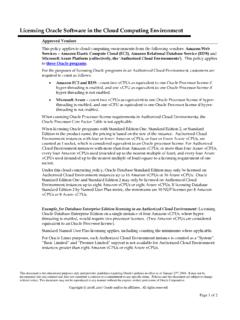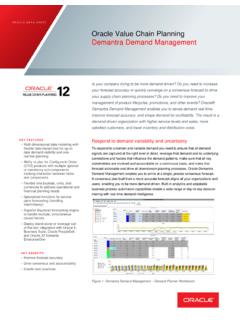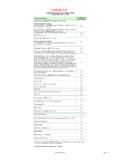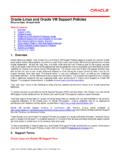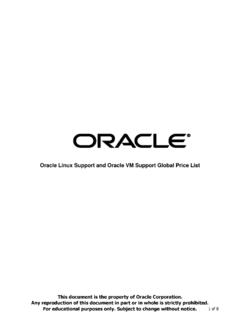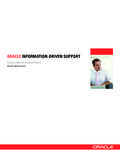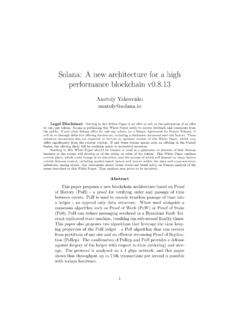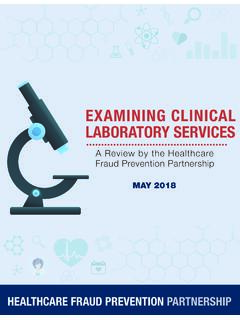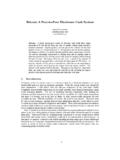Transcription of Oracle White Paper
1 An Oracle White Paper April 2019. Extending Oracle E-Business Suite Release 12 using Oracle APEX. Revision Extending Oracle E-Business Suite Release 12 using Oracle APEX [Revision 3]. Disclaimer The following is intended to outline our general product direction. It is intended for information purposes only, and may not be incorporated into any contract. It is not a commitment to deliver any material, code, or functionality, and should not be relied upon in making purchasing decisions. The development, release, and timing of any features or functionality described for Oracle 's products remains at the sole discretion of Oracle . Extending Oracle E-Business Suite Release 12 using Oracle APEX [Revision 3]. Executive Overview .. 2. Introduction .. 2. What's New .. 2. Prerequisites .. 3. Concept Overview .. 4. Oracle APEX Architecture .. 5. Recommended Mid-Tier Deployment Architecture .. 6. Recommended Database Architecture .. 8. Upgrading to Oracle E-Business Suite Release.
2 10. Installing Oracle APEX .. 12. Oracle APEX Schemas and Workspaces .. 13. Accessing Oracle E-Business Suite Data .. 19. Updating Oracle E-Business Suite Tables .. 21. Downloading and Installing the Sample Code .. 23. Integrating with Oracle E-Business Suite .. 24. Creating an Oracle APEX Application .. 24. Oracle APEX Authentication and Authorization .. 34. Configuring the Oracle APEX Login Process .. 35. Defining Oracle APEX Authorizations .. 39. Installing the Sample Packaged Application .. 44. Defining Oracle E-Business Suite Profile and Form Functions .. 45. Defining Oracle E-Business Suite Menus and 48. Downloading and Installing the Environment 52. Running the Application Express Extension .. 53. Custom Tables on Oracle E-Business Suite .. 55. Upgrading your Application Express Extensions .. 56. Upgrading your APEX Extensions in a Different Database .. 58. Conclusion .. 59. Acknowledgements .. 59. Extending Oracle E-Business Suite Release 12 using Oracle APEX [Revision 3].
3 Executive Overview This Paper outlines how to extend Oracle E-Business Suite functionality utilizing Oracle APEX. This Paper is a collaboration between both product teams to ensure that any extensions developed following the strategy outlined in this Paper are fully supported. Recommended architecture and security considerations are discussed in detail. Introduction Oracle E-Business Suite delivers a wide range of functionality to handle core areas of your business processing needs. However, there are situations where you want to extend your information systems beyond the range of Oracle E-Business Suite. Many times these necessary extensions are meant to handle unique industry conventions, specific customer requirements, or perhaps to offer some other competitive edge. Sometimes these change requests are simple enough, but other times more extensive customizations are needed. In these scenarios, Oracle APEX, also known as Oracle Application Express, provides an easy way to create supplemental applications that are easily integrated with your Oracle E-Business Suite and its data.
4 Oracle APEX is a rapid web application development tool for the Oracle database. Oracle APEX combines the qualities of a personal database (productivity, ease of use, and flexibility) with the qualities of an enterprise database (security, integrity, performance, scalability, availability, and built for the web). The browser-based interface, declarative programming framework, and simple wizards make Oracle APEX easy to learn and enable you to quickly build robust applications. Oracle APEX offers you a quick and highly productive way to extend your Oracle E- Business Suite environment with almost no impact to your existing implementation. By moving custom behaviors out of Oracle E-Business Suite and into Oracle APEX, you can make Oracle E-Business Suite patching and upgrading much simpler. You should be able to easily combine your Oracle APEX applications with your Oracle E- Business Suite installation using the architecture and techniques described in this White Paper .
5 What's New Revision 3 of this White Paper includes updates to the supported product versions, new screenshots, and clearer images. This version now includes a new script, , which accepts numerous parameters and then defines all of the required E-Business Suite components, such as a profile option, form functions, menus, responsibility, and creating a user. The existing scripts were also consolidated and simplified. Based on feedback, the custom schema for Oracle APEX given in the examples has been renamed to XX_APEX, instead of APEX_EBS_EXTENSION. Page | 2 of 64. Extending Oracle E-Business Suite Release 12 using Oracle APEX [Revision 3]. Prerequisites The current prerequisites for the solution given in this Paper are: Oracle E-Business Suite or above o This Paper includes specifics instructions that apply to both Oracle E-Business Suite Release and Release o For Oracle E-Business Suite Release , patch 12316083 is required. {Go to My Oracle Support Patches & Updates: }.
6 Full-use Oracle Database1, Release , or above Oracle APEX or above o Oracle recommends installing the latest available version of Oracle APEX. o Screenshots in this Paper utilize APEX , which may vary for other releases. Oracle REST Data Services (ORDS) or above o Oracle recommends installing the latest available version of ORDS. Oracle WebLogic Server (WLS)2 12c or above o You can also utilize Apache Tomcat, or ORDS Standalone (Jetty) Server, instead of Oracle WebLogic Server. Note: The minimum version of products listed above are those supported at time of writing. Please review the relevant Lifetime Support Policy documents for each product to ensure you install supported software, and know when support ends. 1. The limited-use Oracle Database license agreement included with an Oracle E-Business Suite license does not allow for the creation of an additional schema as outlined in this Paper below. Please refer to the following license agreement: Therefore, to be fully compliant, full-use Oracle Database Enterprise Edition and Oracle Internet Application Server Enterprise Edition licenses are required.
7 2. A separate Oracle WebLogic Server license is required, other than the Oracle WebLogic Suite for Oracle Applications, utilized for Oracle E-Business Suite Release E-Business Suite utilizes WLS which does not support installation of JDK 8 which is required by ORDS. Updating WLS for use by EBS is not supported. Page | 3 of 64. Extending Oracle E-Business Suite Release 12 using Oracle APEX [Revision 3]. Concept Overview Oracle APEX offers you the ability to create reports, charts, and calendars as well as pages for data review and manipulation. To allow you to create Oracle APEX applications that reference Oracle E-Business Suite data, the desired data is exposed through database views in the APPS schema. 'SELECT' access to those views is then granted to an existing or new Oracle E-Business Suite custom schema (for this document, XX_APEX). Because direct INSERT', 'UPDATE', and 'DELETE' operations on Oracle E- Business Suite data is unsupported, applications that manipulate Oracle E-Business Suite data will use the public, documented and supported, Oracle E-Business Suite APIs.
8 References to these APIs can either be coded into the Oracle APEX applications or you can define 'INSTEAD OF' triggers against the new database views which call the appropriate APIs. The extensions built in Oracle APEX will appear seamless to your end users because you can use the same authentication (who can login) and authorization (who can see what). within your Oracle APEX applications that are used within your Oracle E-Business Suite installation. Your new applications can either be stand-alone or fully integrated. Stand- alone applications are accessed directly, but use the same login credentials used for Oracle E-Business Suite access. Fully integrated applications are registered within the Oracle E-Business Suite so they are available from within the Oracle E-Business Suite menus. Oracle APEX contains a pre-configured Authentication Scheme for Oracle Single Sign-on (OSSO) and also HTTP Header Variable for use with Oracle Access Manager (OAM). If your Oracle E-Business Suite instance uses OSSO or OAM for authentication, setting up authentication will be very simple.
9 If you are using custom authentication for Oracle E- Business Suite, you can still achieve seamless integration but you will need to code a function within the APPS schema that validates the user, and then add an authentication scheme to your Oracle APEX applications that calls that new function. This document discusses the Oracle APEX architecture and provides detailed instructions for creating all the components necessary to extend Oracle E-Business Suite. In support of the instructions, scripts and sample packaged applications are available for download to ensure that any developer can quickly replicate the examples. Page | 4 of 64. Extending Oracle E-Business Suite Release 12 using Oracle APEX [Revision 3]. Oracle APEX Architecture Figure 1. Oracle APEX Architecture Oracle APEX resides completely within the Oracle Database in its own schema and can be installed on any version of the Oracle Database from 11gR2 and above. Runtime, development and deployment require no client software as access is 100% browser- based via a Web listener communicating with the Oracle Database.
10 The application definitions are stored as meta-data within the Oracle APEX schema which is accessed to perform page rendering and processing. The middle tier requires Oracle REST Data Services (ORDS). ORDS is a JAVA EE based solution that is certified with Oracle WebLogic Server, ORDS Standalone (Jetty Server), and Apache Tomcat. Oracle does not recommend utilizing the Embedded PL/SQL. Gateway (EPG) for integrating Oracle E-Business Suite and Oracle APEX. Note: You can not utilize the Oracle WebLogic Server installed by Oracle E-Business Suite , as this release does not support JDK 8 required by ORDS. It is not supported to update the release of Oracle WebLogic Server utilized by Oracle E-Business Suite. Page | 5 of 64. Extending Oracle E-Business Suite Release 12 using Oracle APEX [Revision 3]. Recommended Mid-Tier Deployment Architecture The recommended configuration is to have two separate application servers, by installing the Oracle REST Data Services within Oracle WebLogic Server, on a separate application server to the one configured for Oracle E-Business Suite.
